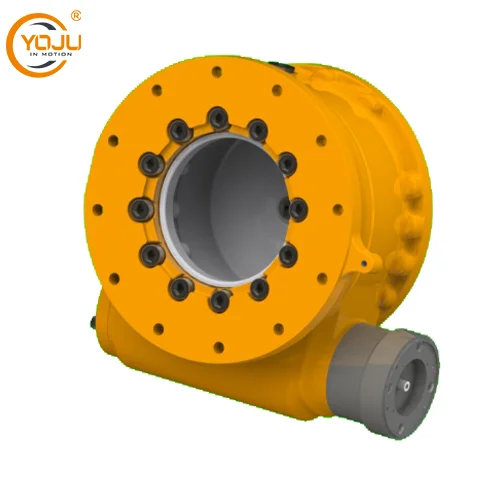Role of Slewing Drive in Solar Thermal System
In the world of renewable energy, solar thermal power is gaining traction as a reliable and sustainable energy source. To maximize energy collection, solar thermal systems rely on precise tracking mechanisms to follow the sun's movement throughout the day. Slewing drives are pivotal in these tracking systems, as they provide the necessary torque and control to ensure optimal positioning. In this blog post, YOJU, as custom slewing drive for solar tracking system manufacturer, will share the role of solar thermal power slewing drive for sale, its features, etc.
What is Slewing Drive and How Does it Work?
A slewing drive is a type of mechanical drive that allows for the rotation of large loads with high torque. It operates by converting input power into rotary motion, typically used for applications requiring precision and strength. In the context of solar thermal power, slewing drives are used in tracking systems to rotate solar panels or mirrors. These systems ensure that the solar collector always faces the sun, maximizing efficiency and energy production.
At the heart of a slewing drive is a horizontal worm shaft with perpendicular gears, which efficiently transfers torque force. This design enables the slewing drive to provide high magnified torque with relatively low power input, making it ideal for solar tracking applications where precision and reliability are crucial.
Why Slewing Drives are Ideal for Solar Thermal Power Systems
-
High Torque and Precision
Solar thermal systems often require large amounts of torque to move heavy panels or mirrors. Slewing drives are designed to deliver robust radial torque, ensuring that solar collectors stay precisely aligned with the sun at all times. This level of precision is essential for maximizing the efficiency of solar thermal power generation. -
Durability and Reliability
Slewing drives are built to handle high-stress environments. In solar thermal systems, where tracking mechanisms are exposed to the elements, the drive system must be durable enough to withstand harsh weather conditions while maintaining long-term reliability. YOJU slewing drives, with their advanced gearing mechanisms, are known for their exceptional durability and performance in such applications. -
Efficient Power Transfer
By utilizing perpendicular gears and horizontal worm shafts, slewing drives efficiently transfer power, reducing energy loss. This efficient transfer of power ensures that the solar tracking system operates with minimal energy consumption, which is crucial for the overall energy efficiency of solar thermal plants.

Key Features of Solar Thermal Power Slewing Drive
-
Compact and Robust Design
Slewing drives are compact and robust, designed to handle the heavy loads associated with solar tracking systems. Their space-efficient design makes them ideal for large-scale solar installations, where space constraints and the need for durable components are major considerations. -
Minimal Maintenance Requirements
One of the most significant advantages of slewing drives is their low maintenance needs. In remote solar thermal plants, reducing the frequency of maintenance is essential to ensure uninterrupted operation. Slewing drives require minimal upkeep, reducing operational costs and downtime. -
Adaptability to Various Solar Thermal Systems
Whether in parabolic troughs, solar towers, or Fresnel systems, slewing drives can be customized to meet the specific needs of different solar thermal configurations. Their adaptability makes them a versatile choice for diverse solar power applications, ensuring compatibility across various systems.
Environmental and Economic Benefits of Using Solar Thermal Power Slewing Drive
-
Environmental Impact
Slewing drives contribute to the sustainability of solar thermal power systems by ensuring maximum energy capture. By improving the efficiency of solar tracking, slewing drives help solar plants generate more power with fewer resources, thereby reducing the overall carbon footprint of the energy production process. -
Cost-Effectiveness
Although slewing drives represent an investment in the initial stages of a solar thermal project, their long-term benefits far outweigh the costs. The precise positioning enabled by slewing drives ensures optimal solar energy capture, leading to higher energy production and better returns on investment. Additionally, the minimal maintenance requirements further reduce operational costs over time.
Challenges and Considerations When Using Slewing Drives for Solar Thermal Systems
-
Initial Investment Costs
While slewing drives offer significant long-term benefits, the initial cost of installing them in solar tracking systems can be high. However, as solar technology advances and manufacturing processes improve, these costs are expected to decrease, making slewing drives more accessible for a wider range of solar thermal applications. -
Temperature Sensitivity
Slewing drives in solar thermal systems are exposed to extreme temperatures, particularly in desert or high-altitude environments where many solar thermal plants are located. The performance of slewing drives can be affected by temperature fluctuations, so selecting drives with temperature-resistant materials is essential to ensure reliable operation.
Future Trends in Slewing Drive Technology for Solar Thermal Power
As the demand for renewable energy continues to rise, slewing drive technology is expected to evolve to meet the growing needs of solar thermal systems. Some of the emerging trends include:
-
Integration with Smart Control Systems
Future slewing drives may be integrated with advanced control systems that use real-time data and AI algorithms to adjust the position of solar collectors for optimal energy capture. This smart technology could further increase the efficiency and automation of solar thermal power systems. -
Lightweight Materials for Improved Efficiency
Advances in materials science could lead to the development of slewing drives made from lighter, stronger materials. This would reduce the overall weight of solar tracking systems, improving their efficiency and lowering transportation and installation costs.
Conclusion
Slewing drives play a critical role in the operation of solar thermal power systems, providing the precision and torque needed to ensure optimal energy capture. With their robust design, minimal maintenance, and high efficiency, they are an essential component for the growth and development of solar thermal technologies. As solar energy continues to play an increasingly important role in the global energy mix, slewing drives will remain at the forefront of ensuring that solar thermal power systems operate at peak performance.
www.enyoju.com
YOJU

